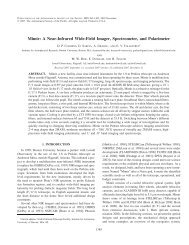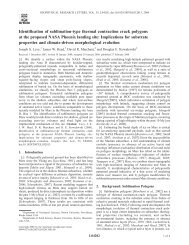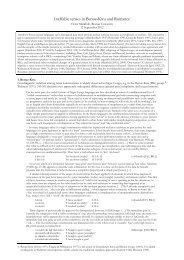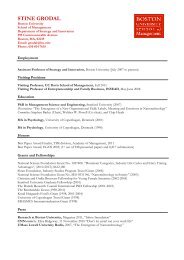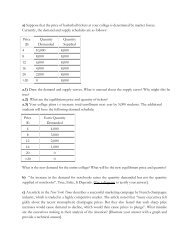Define v = ψ ◦ ū −1 ◦ u, where ū is defined in (13). 21Using Axiom A6, we immediatelyobtain part (iii) of the theorem. Plugging this definition of v in (36) yields:( ∫ ( ) )∑V s t(ĉ, g +1 ) = ξ v ◦ u −1 ◦ ū g +1 (s)π(s) dµ s t(π)P s ts∈S( ∫ ( ∑∫) )= ξ v ◦ u −1 π(s) u(V (c ′ , m ′ ))dg +1 (s)(c ′ , m ′ ) dµ s t(π) ,P s ts∈SC×Mwhere the second equality follows from (13).When restricting V s t to the domain M, we obtain:(∫)V s t(ĉ, m) = ξ ◦ v ◦ u −1 u(V (c ′ , m ′ ))dm(c ′ , m ′ )C×M(∫)= V (ĉ, m) = ζ u(V (c ′ , m ′ ))dm(c ′ , m ′ ) ,C×Mfor all m ∈ M, where the last equality follows from (33). Therefore, we have ξ ◦ v ◦ u −1 = ζ,implying u −1 ◦ ζ −1 ◦ ξ = v −1 .Define:y ≡ V s t(ĉ, g +1 ) = ξ( ∫P s tUsing equation (35), we obtain:v ◦ u −1 ( ∑s∈S∫) )π(s) u(V (c ′ , m ′ ))dg +1 (s)(c ′ , m ′ ) dµ s t(π) .C×MV s t(c, g +1 ) = Ŵ (c, y) = Ŵ ( c, ζ ◦ u(u −1 ◦ ζ −1 (y)) ) = W ( c, u −1 ◦ ζ −1 (y) )(( ∫ ( ∑∫) ))= W c, u −1 ◦ ζ −1 ◦ ξ v ◦ u −1 π(s) u(V (c ′ , m ′ ))dg +1 (s)(c ′ , m ′ ) dµ s t(π)P s ts∈SC×M( ( ∫ ( ∑∫) ))= W c, v −1 v ◦ u −1 π(s) u(V (c ′ , m ′ ))dg +1 (s)(c ′ , m ′ ) dµ s t(π) ,P s ts∈SC×Mwhere the third equality follows from the definition of W in Appendix A1.For any g ∈ G, for each s ∈ S, <strong>and</strong> each (c ′ , g ′ ) in the support of g(s) ∈ ∆(C × G),there exists a risk equivalent (c ′ , m ′ ) ∈ C × M such that (c ′ , m ′ ) ∼ s t ,s (c ′ , g ′ ). Let g +1 bea one-step-ahead act such that g +1 (s)(L ′ ) = g(s)(L) holds for all pairs L ⊂ C × G <strong>and</strong>L ′ ⊂ C × M where L ′ consists of all risk equivalents (c ′ , m ′ ) of corresponding elements(c ′ , g ′ ) in L. By construction, g +1 (s) <strong>and</strong> g (s) are stochastically equivalent. By Axiom A521 Note that ū is increasing on M when M is ordered by first-order stochastic dominance. So its inverseexists.35
(Dynamic Consistency), (c, g) ∼ s t (c, g +1 ). Therefore,V s t(c, g) = V s t(c, g +1 )(( ∫ ( ∑= W c, v −1 v ◦ u −1P s ts∈S( ( ∫ ( ∑∫= W c, v −1 ◦ v ◦ u −1 π(s)P s ts∈S∫) ))π(s) u(V (c ′ , m ′ ))dg +1 (s)(c ′ , m ′ ) dµ s t(π)C×M) ))C×Gu(V s t ,s(c ′ , g ′ ))dg(s)(c ′ , g ′ )dµ s t(π)where we have used the fact that g (s) <strong>and</strong> g +1 (s) are stochastically equivalent to derive thesecond equality.A3. Proof of UniquenessSuppose ({Ṽs t}, ˜W , ũ, ṽ, {˜µ s t}) <strong>and</strong> ({V s t}, W, u, v, {µ s t}) represent the same preference. Onthe domain of deterministic consumption streams C ∞ , each Ṽs tcoincides with the commonfunction Ṽ <strong>and</strong> each V st coincides with the common function V . Since Ṽ <strong>and</strong> V are ordinallyequivalent over C ∞ , there is a monotone transformation Φ such that:By (34), we have Ṽs t = Φ ◦ V s t.SinceṼ (y) = Φ ◦ V (y), for all y ∈ C ∞ .˜W (c, Ṽ (y)) = Ṽ (c, y) = Φ(V (c, y)) = Φ(W (c, V (y))) = Φ(W (c, Φ−1 (Ṽ (y)))),,we deduce that ˜W (c, ·) = Φ(W (c, Φ −1 (·))).On M, ∫ C×M u(V (c′ , m ′ ))dm(c ′ , m ′ ) <strong>and</strong> ∫ C×M ũ(Ṽ (c′ , m ′ ))dm(c ′ , m ′ ) are equivalent mixturelinearrepresentations of the risk preference conditional on the fixed current consumption ĉ.Therefore, there exist constants A, B with A > 0 such that:)ũ(Ṽ (c ′ , m ′ ) = Au(V (c ′ , m ′ )) + B, for all (c ′ , m ′ ) ∈ M.Since Ṽ = Φ ◦ V , we obtain ũ ◦ Φ = Au + B.By construction from Appendix A2, ṽ ◦ ũ −1 ◦ ˜ū = ψ = v ◦ u −1 ◦ ū. By equation (13), we36
- Page 1: Intertemporal Substitution andRecur
- Page 6 and 7: As in KMM (2005, 2009a), we impose
- Page 8 and 9: 2. Review of the Atemporal ModelsIn
- Page 10 and 11: defined over it. Notice that by res
- Page 12: For any c ∈ C, we use δ[c] to de
- Page 15: The axiom below states that the pre
- Page 18: is ambiguity averse if he prefers a
- Page 22 and 23: Axiom B6 (Dynamic Consistency) For
- Page 24 and 25: 3. On the subdomain C × M, we obta
- Page 26 and 27: We can similarly define ambiguity l
- Page 28 and 29: epresentations under these two appr
- Page 30 and 31: where R t+1 is the market return fr
- Page 32 and 33: Segal (1987, 1990) and Seo (2009).
- Page 34 and 35: A Appendix: Proof of Theorems 1 and
- Page 38 and 39: compute:∫˜ū (m) =∫=∫=∫= A
- Page 40 and 41: DefineH = {h = (h 0 , h 1 , h 2 ,
- Page 42 and 43: Lemma 5 We have the homeomorphic re
- Page 44 and 45: Finite-step-ahead acts and densenes
- Page 46 and 47: which is strictly increasing in the
- Page 48 and 49: where the second equality follows f
- Page 50 and 51: D Appendix: Proofs for Section 4.4P
- Page 52 and 53: This relation holds true because i
- Page 54 and 55: In complete markets, the following
- Page 56 and 57: Ergin, H. I. and F. Gul (2009): “
- Page 58: Weil, P. (1989): “The Equity Prem



